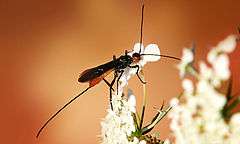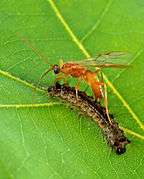Braconidae
| Braconidae | |
|---|---|
 | |
| Atanycolus sp. | |
| Scientific classification | |
| Kingdom: | Animalia |
| Phylum: | Arthropoda |
| Class: | Insecta |
| Order: | Hymenoptera |
| Superfamily: | Ichneumonoidea |
| Family: | Braconidae |
| Subfamilies | |
|
47, see text | |
| Synonyms | |
|
Stenophasmidae Benoit, 1949 | |
The Braconidae is a large family of parasitoid wasps. There are approximately 17,000 recognized species and many thousands more undescribed.[1] One analysis estimated a total between about 30,000 and 50,000, and another provided a narrower estimate between 42,000 and 43,000 species.[1]

Classification
Braconidae are currently divided into about 47 subfamilies and over 1,000 genera,[2] which include Ademon, Aleiodes, Aphanta, Asobara, Bracon, Cenocoelius, Chaenusa, Chorebidea, Chorebidella, Chorebus, Cotesia, Dacnusa, Kollasmosoma, Microgaster, Opius, Parapanteles, Phaenocarpa, and Psenobolus.
These fall to two major groups, informally called the cyclostomes and noncyclostomes. In cyclostome braconids, the labrum and the lower part of the clypeus are concave with respect to the upper clypeus and the dorsal margin of the mandibles. These groups may be clades that diverged early in the evolution of braconids.[3]
Subfamilies
|
|
|
|
|
Morphology
The morphological variation among braconids is notable. They are often black-brown (sometimes with reddish markings), though some species exhibit striking coloration and patterns, being parts of Müllerian mimicry complexes. They have one or no recurrent veins, unlike other members of the Ichneumonoidea, which usually have two. Wing venation patterns are also divergent to apparent randomness. The antennae have 16 segments or more; the hind trochanters have two segments.
Females often have long ovipositors, an organ that largely varies interspecifically. This variation is closely related to the host species upon which the wasp deposits its egg. Species that parasitize microlepidopterans, for instance, have longer ovipositors, presumably to reach the caterpillar through layers of plant tissue. Some wasps also have long ovipositors because of caterpillar defense mechanisms such as spines or hairs, or to reach deeply-burrowed coleoptera larvae in rotting tree trunks. [4]
Parasitism
Most braconids are internal and external primary parasitoids on other insects, especially upon the larval stages of Coleoptera, Diptera, and Lepidoptera, but also some hemimetabolous insects such as aphids, Heteroptera, or Embiidina. Most species kill their hosts, though some cause the hosts to become sterile and less active. Endoparasitoid species often display elaborate physiological adaptations to enhance larval survival within the host, such as the co-option of endosymbiotic viruses for compromising host immune defenses. These polydnaviruses are often used by the wasps instead of a venom cocktail. The DNA of the wasp actually contains portions that are the templates for the components of the viral particles and they are assembled in an organ in the female's abdomen known as the calyx.[5] A 2009 study has traced the origins of these templates to a 100-million-year-old viral infection whose alterations to its host DNA provided the necessary basis for these virus-like "templates".[6]
These viruses suppress the immune system and allow the parasitoid to grow inside the host undetected. The exact function and evolutionary history of these viruses are unknown. Sequences of polydnavirus genes show the possibility that venom-like proteins are expressed inside the host caterpillar. Through the evolutionary history of being used by the wasps, these viruses apparently have become so modified, they appear unlike any other known viruses today. Because of this highly modified system of host immunosuppression, a high level of parasitoid-host specificity is not surprising.
Parasitism on adult insects (particularly on Hemiptera and Coleoptera) is also observed. Members of two subfamilies (Mesostoinae and Doryctinae) are known to form galls on plants.
Larval development


Larvae can be found on diverse hosts, including aphids, bark beetles, and foliage-feeding caterpillars. Many species are parasitoid wasps that attack host eggs or larvae; hence they are often used as biological pest control agents, especially against aphids.[7]
Natural history
The family seems to date from early Cretaceous (provided that Eobracon is properly assigned to this family). It underwent extensive diversification from mid or late Cretaceous to early Cenozoic, correlating with the radiation of flowering plants and associated herbivores, the main hosts of braconids.
Differentiation from Ichneumonidae
Braconidae are distinguished from their sister group Ichneumonidae by these character combinations. In Braconidae, vein 2m-cu of the forewing is absent- this vein is present in 95% of Ichneumonidae. Vein 1/Rs+M of the forewing is 85% present in Braconidae, but absent in all Ichneumonidae. Vein 1r-m of the hind wing is in 95% of Braconidae basal to the separation of R1 and Rs (it is opposite or apical in Ichneumonidae). In Braconidae, metasomal tergum 2 is fused with tergum 3, (secondarily flexible in Aphidiinae) - 90% of Ichneumonidae have a flexible suture.[8]
Other characteristics
The species Microplitis croceipes possesses an extremely accurate sense of smell and can be trained for use in narcotics and explosives detection.[9]
At least some Braconidae appear to be very resistant to ionizing radiation. While a dose of 400 to 1000 rads can kill an average human, a dose of 180,000 rads was required to kill a braconid of genus Hadrobracon in an experiment.[10]
Gallery
 Cotesia melanoscela
Cotesia melanoscela Aleiodes indiscretus ovipositing in its host, a gypsy moth caterpillar
Aleiodes indiscretus ovipositing in its host, a gypsy moth caterpillar_cat_W_IMG_2862.jpg) Apanteles sp. cocoons on Papilio demoleus
Apanteles sp. cocoons on Papilio demoleus- Braconid wasp empty cocoons
References
- 1 2 Jones, O. R., et al. (2009). Using taxonomic revision data to estimate the geographic and taxonomic distribution of undescribed species richness in the Braconidae (Hymenoptera: Ichneumonoidea). Insect Conservation and Diversity 2(3), 204-12.
- ↑ Beyarslan, A. and M. Aydogdu. (2013). Additions to the rare species of Braconidae fauna (Hymenoptera: Braconidae) from Turkey. Mun Ent Zool 8(1) 369-74.
- ↑ Wharton, R. M. (2000). "Can braconid classification be restructured to facilitate portrayal of relationships?". In Austin, A. D.; Dowton, M. Hymenoptera: evolution, biodiversity, and biological control. 4th. International Hymenopterists Conference. Collingwood, Victoria, Australia: Commonwealth Scientific and Industrial Research Organisation (CSIRO). pp. 143–153. ISBN 0-643-06610-1.
- ↑ http://scholarcommons.scu.edu/cgi/viewcontent.cgi?article=1018&context=bio
- ↑ Piper, R. (2007), Extraordinary Animals: An Encyclopedia of Curious and Unusual Animals, Greenwood Press.
- ↑ Bézier, A., et al. Polydnaviruses of braconid wasps derive from an ancestral nudivirus. Science Magazine 323(5916), 926-30. February 13, 2009.
- ↑ Mahr, S. (February 1998). "Know Your Friends: Aphidius Wasps". Midwest Biological Control News Online. University of Wisconsin–Madison. Retrieved 25 March 2013.
- ↑ Sharkey, M. J. Family Braconidae. pp. 362-94 In: Goulet, H. and J. Huber (eds.) Hymenoptera of the World, an Identification Guide to Families. Agriculture Canada Research Branch Monograph No. 1894E. 1993.
- ↑ Hall, M. Scientists recruit wasps for war on terror. USA Today December 26, 2005. Accessed June 19, 2012.
- ↑ Cockroaches and radiation. ABC Science. February 23, 2006.
External links
| Wikimedia Commons has media related to Braconidae. |
| Wikispecies has information related to: Braconidae |
- Braconidae. Tree of Life.
- Braconidae. Encyclopedia of Life.
- Sharkey, M. J. (2004). Synopsis of the Agathidinae (Hymenoptera: Braconidae) of America north of Mexico. Proceedings of the Russian Entomological Society 75(1), 134–52.
- Ghahari, H., et al. Bibliography of the family Braconidae (Hymenoptera: Ichneumonoidea) (1964-2003). NNM Technical Bulletin 8. 2006. ISSN 1387-0211
- van Achterberg, C. and C. O'Toole. (1993). Annotated catalogue of the types of Braconidae (Hymenoptera) in the Oxford University Museum. Zoologische Verhandelingen 287(1) 1-43.
Species profiles from the University of Florida Institute of Food and Agricultural Sciences:
- Cotesia marginiventris
- Diachasmimorpha longicaudata
- Doryctobracon areolatus
- Meteorus autographae
- Opius dissitus
- Utetes anastrephae
Further reading
- Achterberg, C. van (1990): Illustrated key to the subfamilies of the Holarctic Braconidae (Hymenoptera: Ichneumonoidea) Zoologische Mededelingen Vol. 64 p. 1-20 PDF
- Achterberg, C. van (1993): Illustrated key to the subfamilies of the Braconidae (Hymenoptera: Ichneumonoidea) Zoologische Verhandelingen Vol. 283 p. 1-189 PDF
